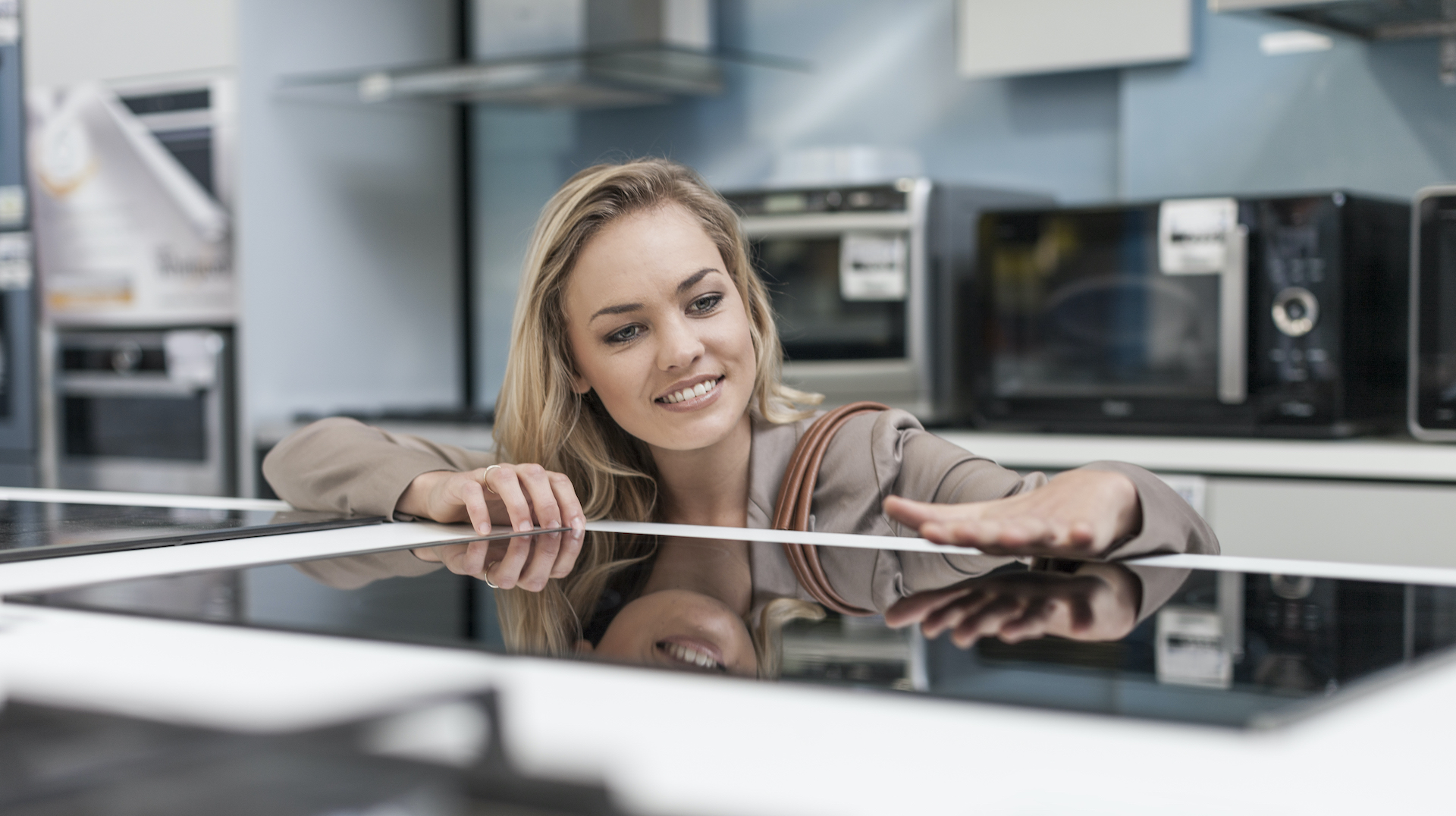

Derek Adams
Induction hobs, or induction cooktops, if you're American, are no longer the 'hottest' thing in cooking – that would be air fryers. However, with more energy-efficient cooking than gas or ceramic hobs, easy-clean surfaces and air of sci-fi mystery, there is still plenty of interest in induction. I've been using an induction hob for several years, largely because it is impossible to get a gas supply in the apartments where I live. I occasionally think I would like to go back to gas, but on the whole I'm very happy with my AEG induction hob. Not as happy as the woman in the photo above, admittedly – I don't literally caress my hob, nor gaze lovingly at it – but pretty, pretty, pretty happy.
You may not understand how induction even works – it's all about high-powered magnets, which heat any steel or iron pan you put on it without the hob itself actually radiating heat. However, you don't need to understand the science to appreciate that induction is an extremely efficient way to cook. It provides faster heating than gas and in many ways is more controllable, once you get used to it. It's usually cheaper to run than gas and any previous form of electric hob, too, especially at current energy prices.
While many home chefs may still prefer cooking with gas, there’s no denying that induction is a faster and more energy-efficient method for heating pots and pans. In pretty much all online tests, induction has proved to be far and away the fastest method to boil a pot of water. Of course, boiling water rapidly is hardly the be-all and end-all of successful cooking, but it's a handy feature.
More importantly, induction hobs are also incredibly quick to respond to temperature adjustments and are incredibly precise. You can boost them all the way to around 315˚C, or put them on their lower settings and leave a pot on there for hours, if not days. The science of induction means the hob itself doesn't heat up, making induction the safest cooking method for anyone with children and/or inquisitive cats. Although please note that the hob will not be completely cool after cooking, because the heat of the pans used will conduct back into it. What we are saying is, don't come crying to us if you decide to demonstrate to guests that induction hobs don't heat up, and end up burning your hand.
Even if you buy the very best induction hob, it’s not much use if you don’t know how to use it. As well as this guide to cooktop catastrophes to avoid, you can also read our guide, 'What is an induction hob?' for more information on the science and practice of induction cooking.
Because, as much as I now love my induction hob, there are various elements of them that are not widely known. As a result, mistakes can be easily made when you 'go induction'. Here's what I wish I'd known before making the leap.
1. Your induction hob’s electrical requirements may be too much for your fusebox
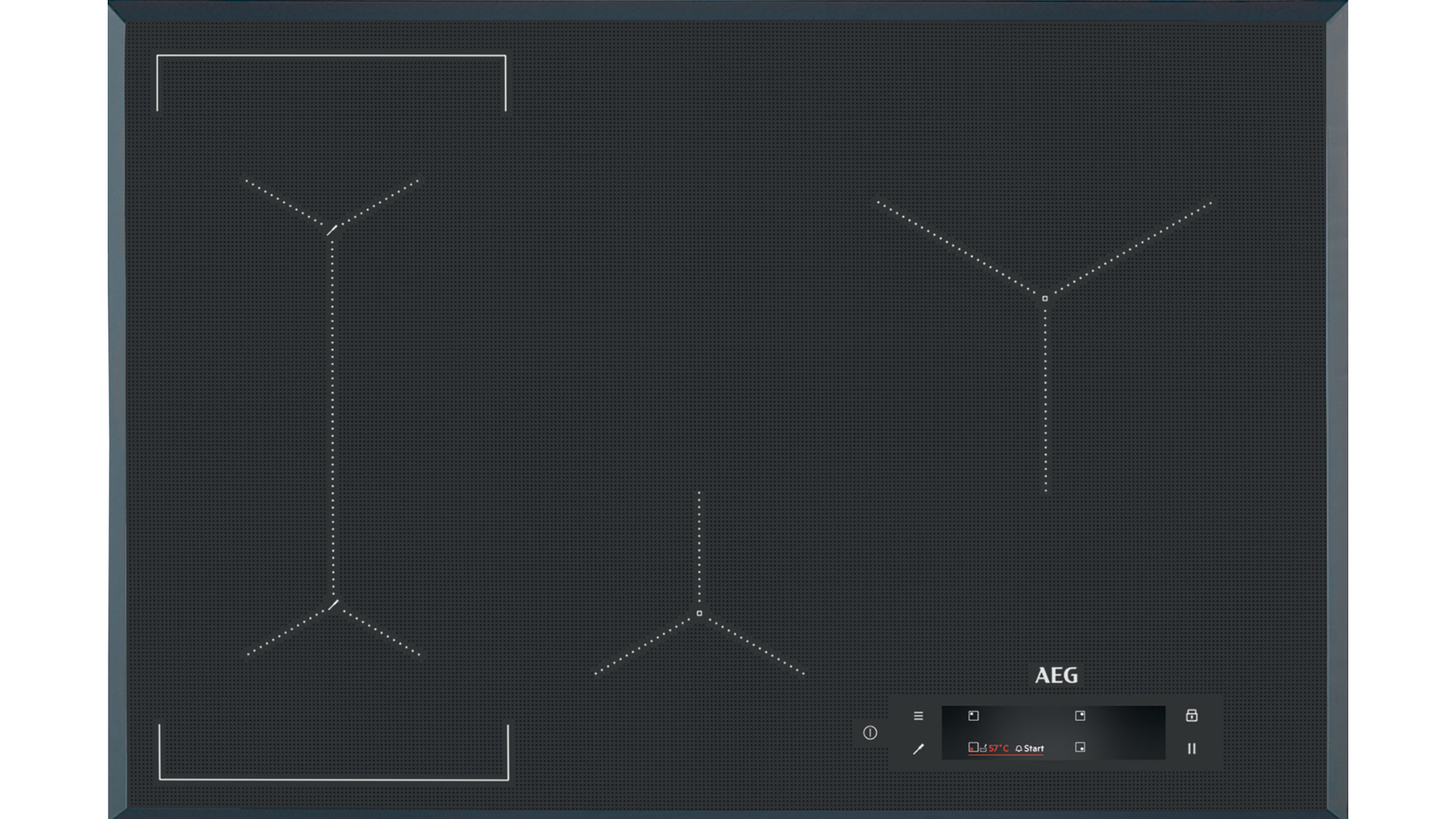
Some high-end induction hobs like this AEG IAE84881FB consume up to 7.4kW of electrical juice
You would think that buying an electric induction hob would be a simple case of selecting the best one for your needs, stumping up the cash and getting an electrician in to wire it up to your existing kitchen ring main. Wrong!
Sign up to the T3 newsletter for smarter living straight to your inbox
Get all the latest news, reviews, deals and buying guides on gorgeous tech, home and active products from the T3 experts
Let me tell you a cautionary tale. A couple of years ago I ordered the most powerful and fully-featured AEG induction hob I could afford. It duly arrived but when the electrician came round to instal it, he first had a look at our mains box and came back in the kitchen with the look of someone about to break grave news. ‘Er, I’m sorry but your existing mains cable isn’t sufficient to carry the greater electrical load required by this hob. I could use the standard diversification method but if you use all the hobs at once while the oven’s also on, the cable may melt and catch fire’. Lovely news.
I’m no electrician but, in a brief-ish nutshell, it seems that a high-end five-zone induction hob with about 7.4kW of power installed above an existing electric oven should ideally be wired to the mains box using 10mm cable and a 45amp fuse. My old flat had a 6mm cable and a 32amp fuse so the electrician suggested a new ring main which added about £400 to the cost – along with having my tiled floor taken up. Be doubly aware of this, especially if you live in an old house or flat and you’re moving from a gas hob to an all-electric system comprising an induction hob and electric oven. This is because, a) the existing ring main may have been installed decades ago when domestic appliances drew less power and b) the electrician may have installed a lower rating cable because the hob used gas which was the most efficient cooking fuel at the time.
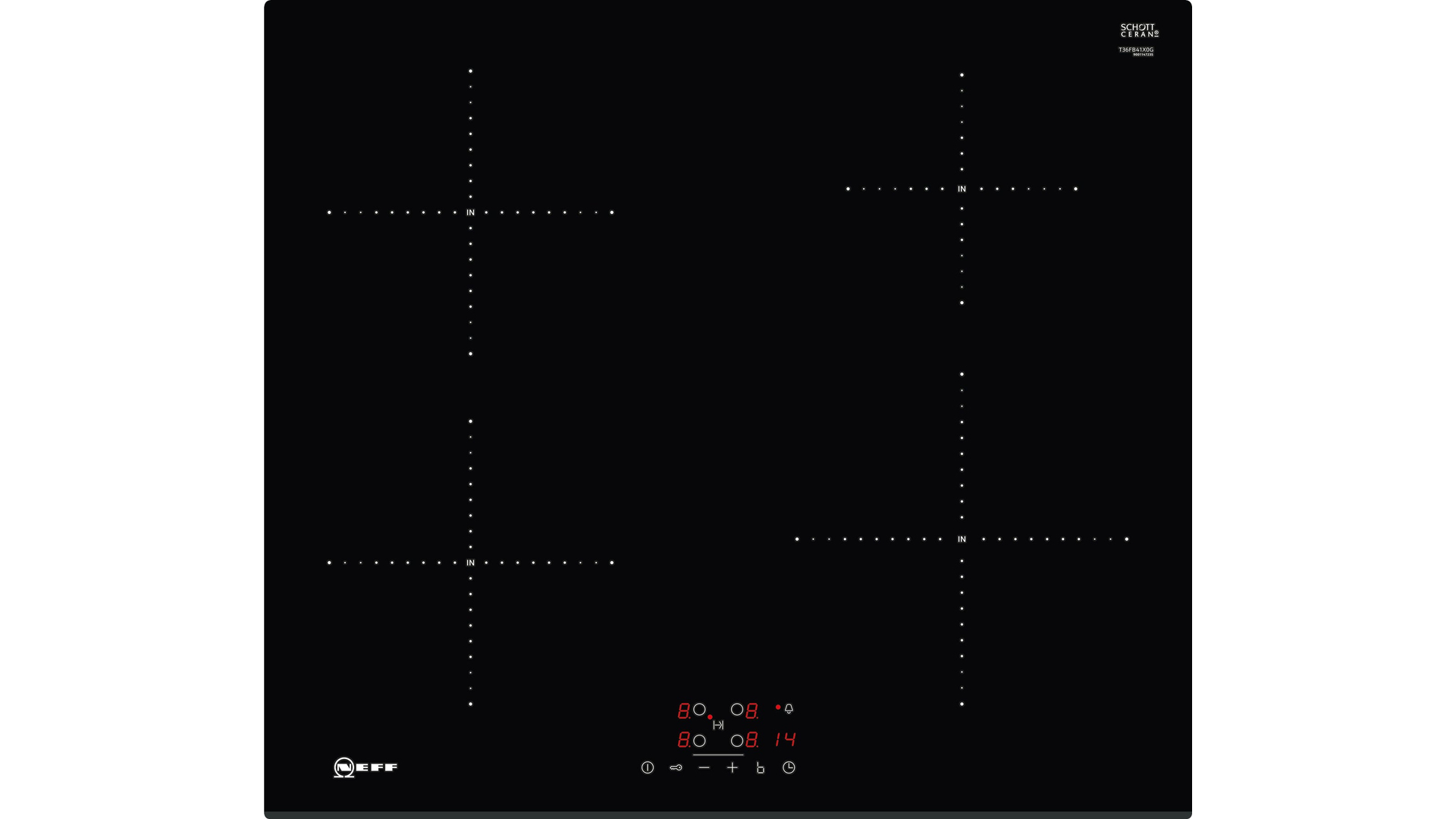
13amp Plug n Play models like the Neff N30 T36CA50X1U can be plugged into a standard UK socket, though there are trade offs in the way they function and perform
There is a practical solution to this power consumption conundrum and it comes in the form of a plug-and-play hob which uses a standard 13-amp mains socket instead of the hob having to be hard wired into the ring main. Many manufacturers like Neff, Bosch, Siemens and Zanussi produce a range of lower-power 13-amp induction hobs but what they don’t always tell you in large, hard-to-miss lettering is that you can’t use all the hobs on full power at the same time. In fact in many instances you can only boil water at full power on one zone at a time. The others would need to function at half power or lower. If using a ‘boost’ function, only one zone can be used, period. That said, you’re rarely likely to be boiling two pots at once – in most cases the other zones will be on half power or lower like, say, when simmering. In that respect, a plug-and-play model will suffice for all but the most discerning of chefs.
The upshot of all this is that it’s extremely important to call in an electrician before selecting an induction hob so he or she can work out the load your electricity supply is capable of handling. You may have to pay a small call-out charge but what price peace of mind?
2. Some of your best cookware may have to go
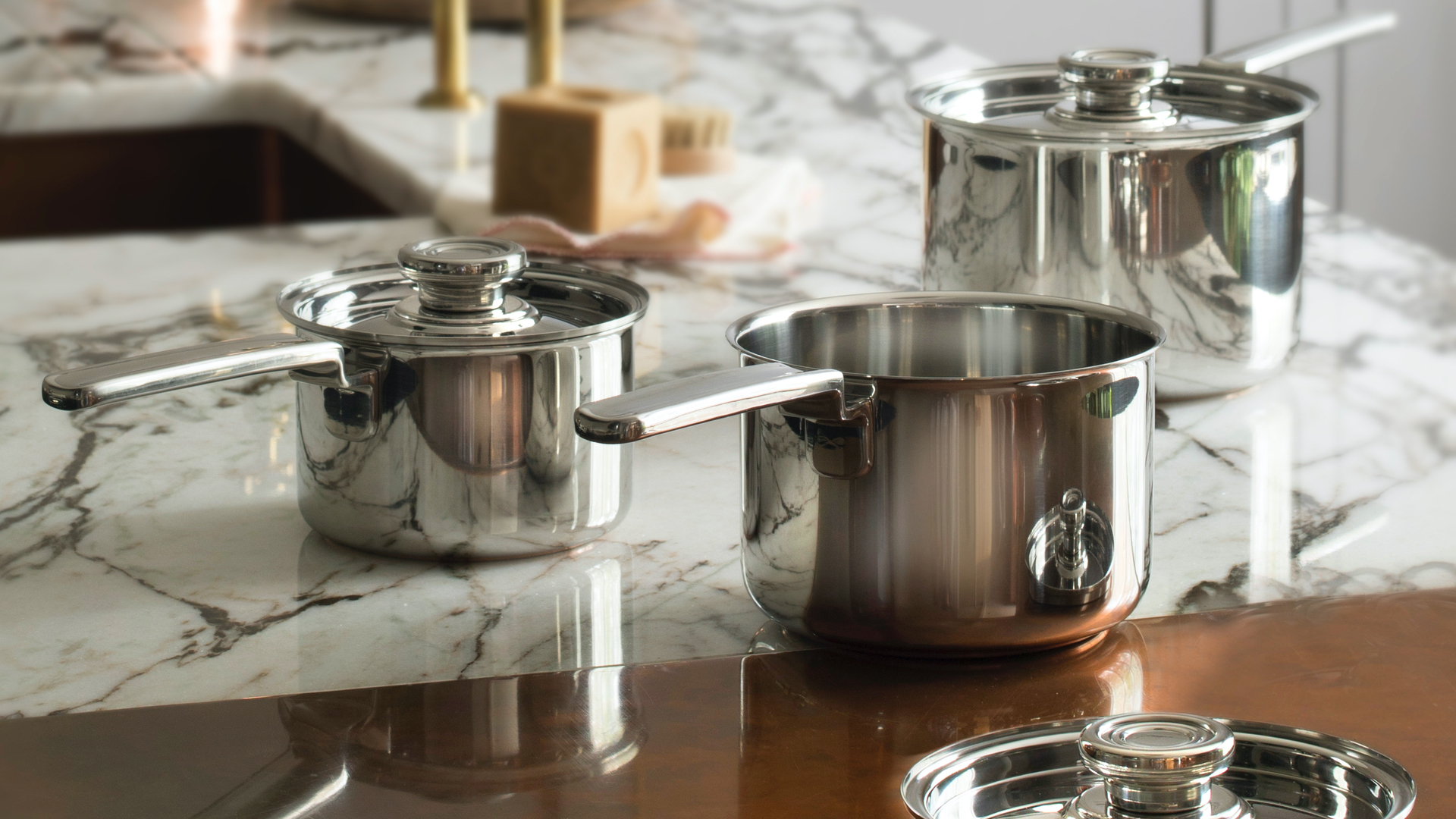
You can't go wrong with Robert Welch's excellent range of induction-ready stainless steel pots and pans
Unlike ceramic or gas hobs that heat the entire pot or pan which in turn transfers the heat to its contents, electric induction hobs heat the ingredients directly using the invisible powers of magnetism. In fact, with the induction system, the pan itself becomes the heat source or element – electromagnetic waves magically penetrate the base of the pot and begin to agitate the electrons in the ingredients, which in turn creates heat for cooking.
Now, since magnetism is the main ingredient here, it stands to reason that the base of any pot or pan used on an induction hob should be made from a ferromagnetic material like cast iron, stainless steel and carbon steel. In short, if a magnet sticks to the underside of the pot or pan, it’s ‘induction ready’. If your existing pans are made entirely from aluminium, copper and, er, glass you will have to bin them or give them to someone who uses gas or ceramic.
However, not all induction pots are made the same because some bases comprise a number of different metals including non-ferrous aluminium and copper which also happen to be excellent heat conductors.
Those are good – often very good – but in my experience, pans made entirely from stainless steel or cast iron are the best types of cookware for induction hobs. You can position them where you like, the hob 'burner' size is less important and they're less hassle all round.
Cast iron takes longer to heat up but the whole pot retains heat for much longer than stainless steel. This makes cast iron the best material for cooking slow-and-low hob-based casseroles and stews (thing Le Creuset) but not, conversely, for anything that requires constant temperature fluctuations. For that you need stainless steel. Since stainless steel has low heat conductivity, many manufacturers apply very thin sandwich layers of aluminium and/or copper to the base of their pans so they have excellent magnetic properties along with superb heat conductivity. To date, our favourite – ie the fastest and most efficient – stainless steel pots and pans are those that hail from the Cotswolds-based Robert Welch stable. We reviewed the company’s Campden 3-Piece Saucepan Set last year and were mightily impressed by the speed with which they boiled water – surprisingly, they were faster to boil than most of our other induction ready pans. Robert Welch saucepans use a base layer comprising a combination of stainless steel with sandwiched layers of aluminium and copper for maximum conductivity. This writer’s been using them regularly for the past year and they still look brand new.
When it comes to the best non-stick frying pans for induction hobs, we’ve been equally impressed by the Samuel Groves Tri-Ply Stainless Steel Non-Stick Frying Pan and the Le Creuset Toughened Non-Stick Shallow Bring Pan.
3. …And you need to think about the size of your pans too
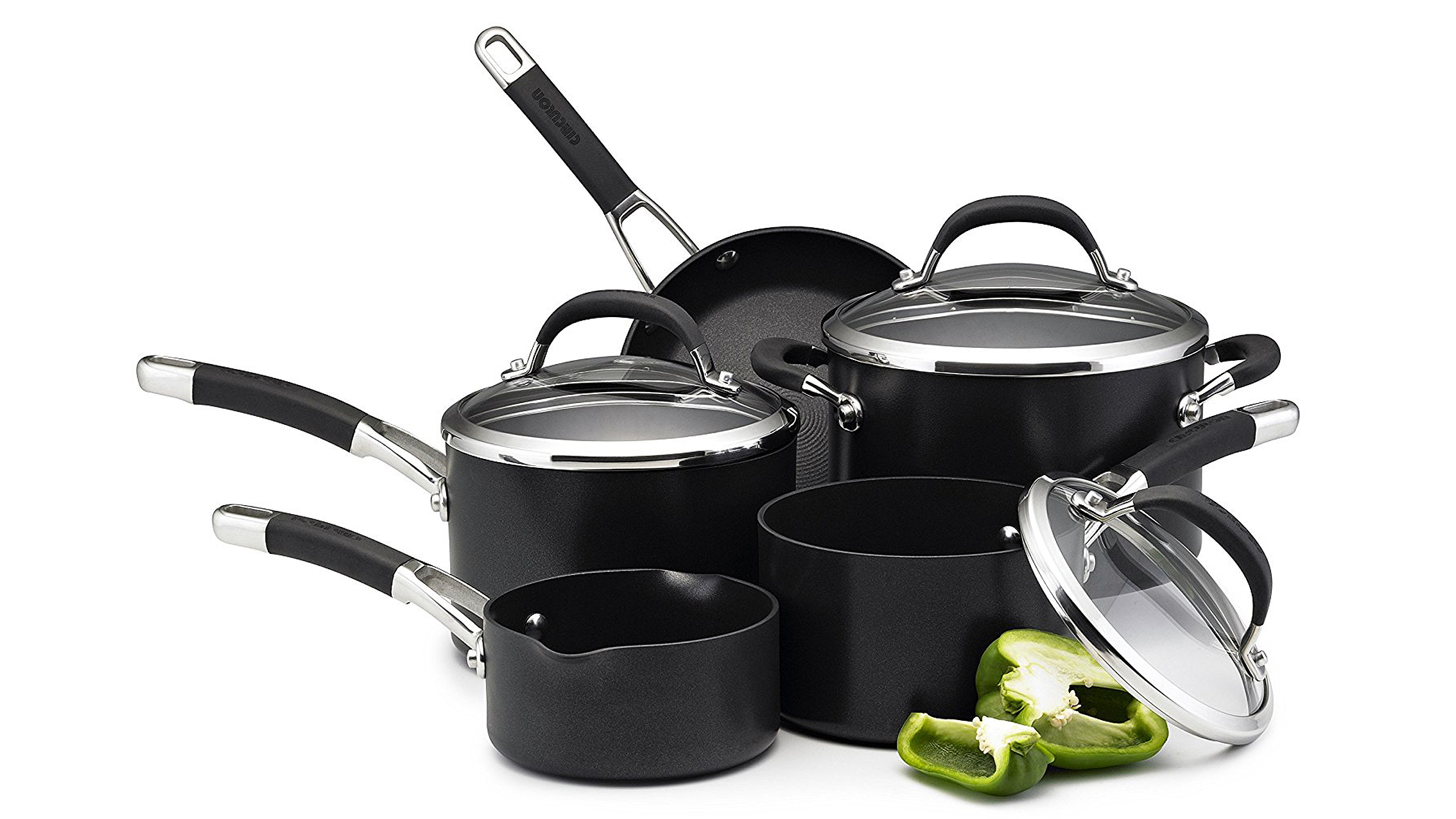
Most people are probably aware that the pans you use on an induction hob need to have a base that is made of, or at least contains a disc of, ferrous metal. That is to say, iron or steel. However, what is perhaps less widely known is that the ideal pan for an induction hob should be as near to the size of the actual hob ring as possible.
The reason for this is simple. Because induction hobs cook using magnetism, they do not actually radiate heat, in the way that a gas or old-style electric hob does. So any part of a pan that is not on the ring, due to poor placement, or being bigger than the ring, will not heat up anywhere near as much as the part of the pan that is in direct contact with the ring.
This can actually be useful for certain types of cooking, as you can move food to the outer edges so it stays warm but cooks more slowly, while you use the middle of the pan to properly sear more food. However, it can also cause problems if you're not aware of it.
Some newer (and usually more expensive) induction hobs largely do away with this problem by having large cooking areas that can heat pans of practically any size, but if yours has rings, it's important to use the right sized cookware.
4. Cleaning an induction hob isn't a complete walk in the park

This may be like teaching grandma to suck eggs, but don’t under any circumstances use a scourer to clean your induction hob. This is because all induction hobs have a glass surface that is easily scratched. You’re much better off cleaning the glass top with a damp sponge, a few drops of washing up liquid and a good dose of elbow grease. Then finish it off with a good buff using a soft dry microfibre cloth.
If the hob is especially grubby or shows signs of pot stains that can’t be removed using washing up liquid, try the vinegar and baking soda method. Combine one part baking soda with one part white vinegar in a bowl or spray bottle and apply it to the hob. Leave for 30 minutes, wipe off with a damp sponge and give it a buff with a dry cloth. Job done.
Since an induction hob's surface never gets hot enough to set fire to anything, another good tip – thanks John – is to place a piece of kitchen paper towel (Blitz is best) or even a thin tea towel under the pot or pan to protect the hob's glass surface and at the same time mop up any inevitable spills when boiling obstreperous ingredients like rice and pasta.
5. You're not supposed to use the boost function too much

One of the handiest features of an induction hob is its ability to reach an extremely high heat very quickly, and hold it there. Usually this involves using a 'boost' or 'power' setting on the hob that comes after the top numerical setting. It's very tempting to use this all the time but you really shouldn't. Best practice is to use the boost briefly, to get your pan up to temperature from cold, then turn down to 8 or 9 at most. It's also very useful when you add something new to the pan – adding wine to a sauce for instance – to get the pan back to boiling point very rapidly.
The reason you shouldn't overuse it is simple: most domestic pans just aren't built to be at such extreme heat for any prolonged length of time, and can potentially suffer warping and other damage. That's not all though. Pans that are that hot can also start to mark the surface of the hob itself. My own hob sadly bears the scars of this, and while it doesn't seem to have affected its performance, it has marred the clean and seamless appearance of the hob.
Induction hobs are extremely efficient, and can usually cook very effectively on settings from 3 to 7 – the lower settings are more for keeping things warm. Use the top settings sparingly, especially boost.
Oh, and of course, one other potential pitfall of the boost setting is that it can take liquids in a pan from tepid to boiling over in the blink of an eye. This can be highly dramatic, and will totally mess up your cooking surface and worktop, so don't get distracted and wonder off while heating up, for instance, pasta.
6. You can't cook as if you're still using gas
Probably the hardest thing about induction for many experienced cooks, is that you have to relearn how to cook, to an extent. The most important practical difference between induction and gas is that pans must be in contact with the surface in order to cook food. This sounds simple, but makes one change to your cooking technique very important.
Most people who have cooked on gas are in the habit of lifting the pan slightly off the hob and flipping or shuffling it to move food around so it cooks evenly and doesn't stick. If you do that with induction, the food will almost immediately stop cooking. What you have to do instead is leave the pan where it is, and move the food with a suitable spatula or spoon, made of wood or silicone, ideally. This sounds very simple, and indeed, it is very simple. It took me absolutely ages to fully grasp that lifting and flicking the pan is not a good idea with induction, though.
It's also worth noting that you shouldn't slide the pan back and forth while it's still on the hob either. This manoeuvre doesn't break the contact with the induction surface, so it's good from a cooking point of view. However it can damage the relatively fragile ceramic glass of your induction hob, so it's a move that is best avoided for that reason.
Other things you'll have to get used to are cooking on lower power settings than you're used to – see mistake #5, above – or reducing cooking times. Induction may not involve flames, but it can be fierce.
- More mistakes to dodge
- Mistakes everyone makes when growing houseplants
- Mistakes everyone makes with vacuum cleaners
- Mistakes everyone makes with their coffee machine
- Mistakes everyone makes with Le Creuset and other premium pans
- Mistakes everyone makes with air fryers
- Mistakes everyone makes with ebikes
- Mistakes every cyclist makes with bikes
- Mistakes everyone makes with their fridge freezer
- Mistakes everyone makes with air purifiers
Duncan is the former lifestyle editor of T3 and has been writing about tech for almost 15 years. He has covered everything from smartphones to headphones, TV to AC and air fryers to the movies of James Bond and obscure anime. His current brief is everything to do with the home and kitchen, which is good because he is an excellent cook, if he says so himself. He also covers cycling and ebikes – like over-using italics, this is another passion of his. In his long and varied lifestyle-tech career he is one of the few people to have been a fitness editor despite being unfit and a cars editor for not one but two websites, despite being unable to drive. He also has about 400 vacuum cleaners, and is possibly the UK's leading expert on cordless vacuum cleaners, despite being decidedly messy. A cricket fan for over 30 years, he also recently become T3's cricket editor, writing about how to stream obscure T20 tournaments, and turning out some typically no-nonsense opinions on the world's top teams and players.
Before T3, Duncan was a music and film reviewer, worked for a magazine about gambling that employed a surprisingly large number of convicted criminals, and then a magazine called Bizarre that was essentially like a cross between Reddit and DeviantArt, before the invention of the internet. There was also a lengthy period where he essentially wrote all of T3 magazine every month for about 3 years.
A broadcaster, raconteur and public speaker, Duncan used to be on telly loads, but an unfortunate incident put a stop to that, so he now largely contents himself with telling people, "I used to be on the TV, you know."
-
 3 overrated shoulder exercises, according to a fitness expert (and what to do instead)
3 overrated shoulder exercises, according to a fitness expert (and what to do instead)Sculpt 3D shoulders whilst minimising injury with these three alternative exercises
By Bryony Firth-Bernard Published
-
 Polar’s new subscription feature lands in the shadow of Garmin’s Connect+ rollout
Polar’s new subscription feature lands in the shadow of Garmin’s Connect+ rolloutPR genius or timing disaster? Polar’s new Fitness Programme adds adaptive training to its ecosystem
By Matt Kollat Published